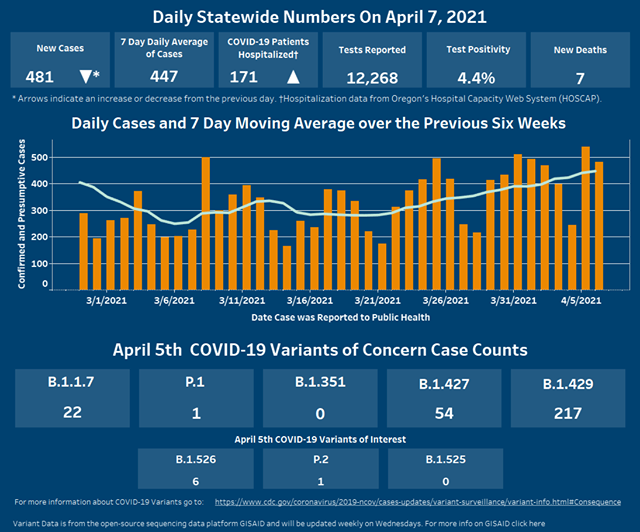April 7, 2021

For Oregonians who live and work in rural areas, getting to a COVID-19 vaccine site may be a challenge. To help make it easier, the Federal Emergency Management Agency (FEMA) sent a mobile vaccine unit (MVU) – along with eight FEMA vaccination support staff – to the state. The MVU team began its service April 5 in Boardman. Oregon Health Authority (OHA), Morrow County Public Health and FEMA, along with community partners like Oregon Rural Action, planned and staffed a multi-day vaccine event. In the first three days, more than 300 people in the Morrow County area were vaccinated.
OHA Field Operations Director, Kassie Clark, coordinated the event along with federal and local partners. “These events are truly a collaborative process with FEMA, the county, and community partners serving those who work and live in the county,” she said.

The MVU is fully equipped with refrigerated storage units and materials to assist clinics using any of the three authorized vaccines. The FEMA team will be assigned to mostly rural areas and specifically focused on reaching out to folks who work in agriculture and food processing.
After the Boardman clinic, pictured, the MVU team travels to Irrigon April 9 and 10, Heppner April 12 and 13, Malheur County April 16, and then Crook County.
|

If you’ve gotten a Pfizer-BioNTech or Moderna COVID-19 vaccine, you’ll need a second shot before you are fully immunized. Getting a second shot will give you the most protection. You should get your second shot even if you have side effects after the first shot, unless a vaccination provider or your doctor tells you not to get it.
You may have had side effects from your first shot and don’t want to experience them again. Even though getting vaccinated may result in some discomfort, the side effects produced from vaccination are minor compared to those that can be produced from COVID-19. While side effects can be uncomfortable for a short time, they are not as difficult as actually having the illness. COVID-19 can cause severe illness which can lead to hospitalization and sometimes death.
Here’s what you need to know about getting a second shot:
-
If you received the Pfizer-BioNTech COVID-19 Vaccine, you should get your second shot three weeks (or 21 days) after your first.
-
If you received the Moderna COVID-19 Vaccine, you should get your second shot four weeks (or 28 days) after your first.
-
Schedule your second shot at the same location as you got the first shot.
-
If you missed the timeline for your second dose, you may still be able to receive it. Check with your vaccinator or health care provider.
 
If you’re an immigrant, you may have concerns about getting the COVID-19 vaccine. Oregon Health Authority (OHA) believes that everyone should have the opportunity to be vaccinated. We want you to have the facts:
-
All eligible people in Oregon can get the vaccine.
-
You do NOT need to be a U.S. citizen.
-
Getting the vaccine will NOT affect your immigration status or count as a public charge.
-
You do not need to have or provide a social security number.
-
You do not need to have identification.
If you need support or information on resources for help you can call the Safe + Strong Helpline: 1-800-923-HELP (4357).
 
Starting today, the Oregon Health Authority is publishing a Tableau dashboard showing the cumulative count of SARS-CoV-2 variants of concern or variants of interest in Oregon. For additional information on COVID-19 variants, go here.
The dashboard will include a map of variant cases broken down by Oregon’s seven Hospital Preparedness Program Regions, along with a time series showing variant cases in Oregon by collection date. The dashboard will be updated weekly on Wednesdays and include data through the previous Saturday.
In order to provide a more comprehensive picture of variant circulation in Oregon, OHA will update its variant counts on the new dashboard using data from the GISAID Initiative — a publicly available scientific database for genetic sequences. This will allow OHA to rapidly report historical data whenever definitions of variants of concern or variants of interest are updated by the Centers for Disease Control and Prevention (CDC).
On March 16, the CDC reclassified the B.1.427 and B.1.429 variants as variants of concern. These variants have been circulating in Oregon since late 2020 and had not been previously reportable.
Oregon will continue to ask all laboratory partners to promptly report all variants of concern (B.1.1.7, B.1.351, P.1, B.1.427 and B.1.429) and variants of interest (B.1.525, B.1.526 and P.2) to public health authorities in order to inform case investigation and contact tracing.
 
There are seven new COVID-19 related deaths in Oregon, raising the state’s death toll to 2,434, the Oregon Health Authority reported at 12:01 a.m. today.
Oregon Health Authority reported 481 new confirmed and presumptive cases of COVID-19 as of 12:01 a.m. today, bringing the state total to 168,128.
Today, OHA reported that 36,104 new doses of COVID-19 vaccinations were added to the state immunization registry. Of this total, 24,097 doses were administered on April 6 and 12,007 were administered on previous days but were entered into the vaccine registry on April 6. Cumulative daily totals can take several days to finalize.
Oregon has now administered a total of 1,057,696 doses of Pfizer, 952,957 doses of Moderna and 55,505 doses of Johnson & Johnson COVID-19 vaccines. As of today, 802,090 people have completed a COVID-19 vaccine series. There are 1,313,016 people who have had at least one dose.
To date, 1,340,235 doses of Pfizer, 1,198,000 doses of Moderna and 170,400 doses of Johnson & Johnson COVID-19 vaccines have been delivered to sites across Oregon.
These data are preliminary and subject to change. OHA's dashboards provide regularly updated vaccination data, and Oregon’s dashboard has been updated today.
The new confirmed and presumptive COVID-19 cases reported today are in the following counties: Baker (4), Benton (9), Clackamas (55), Clatsop (4), Columbia (13), Coos (5), Crook (1), Deschutes (32), Douglas (11), Harney (1), Hood River (1), Jackson (23), Jefferson (1), Josephine (17), Klamath (11), Lake (2), Lane (40), Lincoln (3), Linn (21), Malheur (3), Marion (29), Morrow (3), Multnomah (92), Polk (11), Sherman (2), Tillamook (4), Umatilla (5), Union (1), Wallowa (3), Wasco (3), Washington (61) and Yamhill (10).
Oregon’s 2,428th COVID-19 death is a 60-year-old man in Clackamas County who tested positive on March 29 and died on April 6 at his residence. Presence of underlying conditions is being confirmed.
Oregon’s 2,429th COVID-19 death is a 90-year-old woman in Douglas County who tested positive on Feb. 22 and died on March 25 at her residence. She had underlying conditions.
Oregon’s 2,430th COVID-19 death is a 96-year-old woman in Deschutes County who tested positive on March 29 and died on March 30 at her residence. She had underlying conditions.
Oregon’s 2,431st COVID-19 death is a 72-year-old man in Jackson County who tested positive on Feb. 1 and died on April 5 at Asante Three Rivers Medical Center. He had underlying conditions.
Oregon’s 2,432nd COVID-19 death is a 51-year-old woman in Multnomah County who tested positive on March 9 and died on March 30 at Kaiser Sunnyside Hospital. Presence of underlying conditions is being confirmed.
Oregon’s 2,433rd COVID-19 death is a 67-year-old man in Polk County who tested positive on March 6 and died on April 5 at Salem Hospital. He had underlying conditions.
Oregon’s 2,434th COVID-19 death is a 48-year-old man in Union County who tested positive on Nov. 11 and died on March 23 at Legacy Emanuel Hospital. The death certificate listed COVID-19 disease or SARS-CoV-2 as a cause of death or a significant condition contributing to death. He had no underlying conditions.
COVID-19 hospitalizations
The number of hospitalized patients with COVID-19 across Oregon is 171, which is eight more than yesterday. There are 42 COVID-19 patients in intensive care unit (ICU) beds, which is unchanged from yesterday.
The total number of patients in hospital beds may fluctuate between report times. The numbers do not reflect admissions per day, nor the length of hospital stay. Staffing limitations are not captured in this data and may further limit bed capacity.
Learn more about COVID-19 vaccinations
To learn more about the COVID-19 vaccine situation in Oregon, visit our webpage (English or Spanish), which has a breakdown of distribution and other information.
 Did someone forward this to you? You can subscribe here.
|